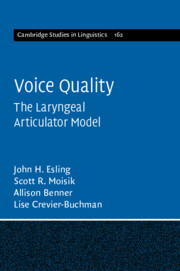Book contents
- Voice Quality
- Series page
- Cambridge Studies in Linguistics
- Voice Quality
- Copyright page
- Contents
- Figures
- Tables
- Preface
- Acknowledgements
- Abbreviations
- 1 Voice and Voice Quality
- 2 Laryngeal Voice Quality Classification
- 3 Instrumental Case Studies and Computational Simulations of Voice Quality
- 4 Linguistic, Paralinguistic, and Extralinguistic Illustrations of Voice Quality
- 5 Phonological Implications of Voice Quality Theory
- 6 Infant Acquisition of Speech and Voice Quality
- 7 Clinical Illustrations of Voice Quality
- 8 Laryngeal Articulation and Voice Quality in Sound Change, Language Ontogeny and Phylogeny
- References
- Author/Artist Index
- Subject Index
4 - Linguistic, Paralinguistic, and Extralinguistic Illustrations of Voice Quality
Published online by Cambridge University Press: 21 June 2019
- Voice Quality
- Series page
- Cambridge Studies in Linguistics
- Voice Quality
- Copyright page
- Contents
- Figures
- Tables
- Preface
- Acknowledgements
- Abbreviations
- 1 Voice and Voice Quality
- 2 Laryngeal Voice Quality Classification
- 3 Instrumental Case Studies and Computational Simulations of Voice Quality
- 4 Linguistic, Paralinguistic, and Extralinguistic Illustrations of Voice Quality
- 5 Phonological Implications of Voice Quality Theory
- 6 Infant Acquisition of Speech and Voice Quality
- 7 Clinical Illustrations of Voice Quality
- 8 Laryngeal Articulation and Voice Quality in Sound Change, Language Ontogeny and Phylogeny
- References
- Author/Artist Index
- Subject Index
Summary
Chapter 4 contains extensive references to exemplifications of the voice quality categories described in Chapters 1 and 2. Distinctive voice quality settings of actors, singers, media announcers, politicians, and other personalities are cited with specific references to be used as search terms to locate video and audio material online. A separate ‘Multimedia References’ section is included at the end of the text to facilitate searching. Long-term voice qualities are essentially extralinguistic, but they can also alternate among phrases of speech as paralinguistic ‘registers’. Many laryngeal postures, and their auditory output, are employed linguistically as syllabic registers or segmental units to signal contrastive lexical meaning. This is a result of the positioning of the laryngeal articulator at the beginning of the shaping of the sound stream, where background elements are easily patterned behind oral articulations. Extensive references to linguistic examples of lower-vocal-tract consonantal strictures and tonal register effects are presented within the text notes and are included among the video and audio materials online.
Keywords
- Type
- Chapter
- Information
- Voice QualityThe Laryngeal Articulator Model, pp. 123 - 154Publisher: Cambridge University PressPrint publication year: 2019

